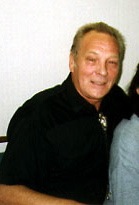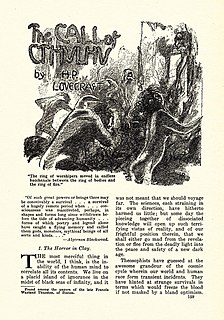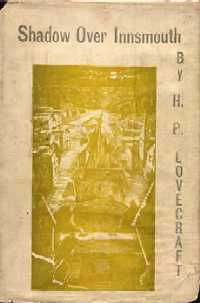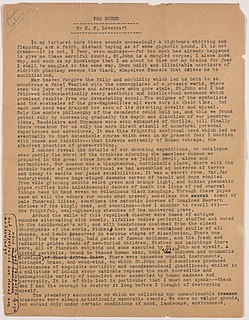Related Research Articles

Brian Lumley is an English author of horror fiction. He came to prominence in the 1970s writing in the Cthulhu Mythos created by American writer H. P. Lovecraft but featuring the new character Titus Crow, and went on to greater fame in the 1980s with the best-selling Necroscope series, initially centered on character Harry Keogh, who can communicate with the spirits of the dead.

"The Call of Cthulhu" is a short story by American writer H. P. Lovecraft. Written in the summer of 1926, it was first published in the pulp magazine Weird Tales in February 1928.
"The Terrible Old Man" is a short story of fewer than 1200 words by American writer H. P. Lovecraft. It was written on January 28, 1920, and first published in the Tryout, an amateur press publication, in July 1921. It is notable as the first story to make use of Lovecraft's imaginary New England setting, introducing the fictional town of Kingsport. The story, about the fate of three would-be robbers of the titular old man's house, has been criticized by Peter Cannon for being an openly xenophobic polemic against immigration.

"The Colour Out of Space" is a science fiction/horror short story by American author H. P. Lovecraft, written in March 1927. In the tale, an unnamed narrator pieces together the story of an area known by the locals as the "blasted heath" in the hills west of the fictional town of Arkham, Massachusetts. The narrator discovers that many years ago a meteorite crashed there, poisoning every living being nearby; vegetation grows large but foul-tasting, animals are driven mad and deformed into grotesque shapes, and the people go insane or die one by one.
"Nona" is a short horror story by Stephen King, first published in the 1978 anthology Shadows and later collected in King's 1985 collection Skeleton Crew.

The Shadow over Innsmouth is a horror novella by American author H. P. Lovecraft, written in November–December 1931. It forms part of the Cthulhu Mythos, using its motif of a malign undersea civilization, and references several shared elements of the Mythos, including place-names, mythical creatures, and invocations. The Shadow over Innsmouth is the only Lovecraft story that was published in book form during his lifetime.

"Pickman's Model" is a short story by H. P. Lovecraft, written in September 1926 and first published in the October 1927 issue of Weird Tales. It was adapted for television in a 1971 episode of the Night Gallery anthology series, starring Bradford Dillman.

"The Outsider" is a short story by American horror writer H. P. Lovecraft. Written between March and August 1921, it was first published in Weird Tales, April 1926. In this work, a mysterious individual who has been living alone in a castle for as long as he can remember decides to break free in search of human contact and light. "The Outsider" is one of Lovecraft's most commonly reprinted works and is also one of the most popular stories ever to be published in Weird Tales.

"From Beyond" is a horror genre short story by American writer H. P. Lovecraft. It was written in 1920 and was first published in The Fantasy Fan in June 1934.
"The Festival" is a short story by H. P. Lovecraft written in October 1923 and published in the January 1925 issue of Weird Tales.

"The Hound" is a short story written by H. P. Lovecraft in September 1922 and published in the February 1924 issue of Weird Tales. It contains the first mention of Lovecraft's fictional text the Necronomicon.
"Hypnos" is a short story by American horror fiction writer H. P. Lovecraft, penned in March 1922 and first published in the May 1923 issue of National Amateur.

"Cool Air" is a short story by the American horror fiction writer H. P. Lovecraft, written in March 1926 and published in the March 1928 issue of Tales of Magic and Mystery.
"The Dreams in the Witch House" is a horror short story by American writer H. P. Lovecraft, part of the Cthulhu Mythos cycle. It was written in January/February 1932 and first published in the July 1933 issue of Weird Tales.
"The Picture in the House" is a short story written by H. P. Lovecraft. It was written on December 12, 1920, and first published in the July issue of The National Amateur—which was published in the summer of 1921.

"The Shunned House" is a horror fiction novelette by American author H. P. Lovecraft, written on October 16–19, 1924. It was first published in the October 1937 issue of Weird Tales.

"Herbert West–Reanimator" is a horror short story by American writer H. P. Lovecraft. It was written between October 1921 and June 1922. It was first serialized in February through July 1922 in the amateur publication Home Brew. The story was the basis of the 1985 horror film Re-Animator and its sequels, in addition to numerous other adaptations in various media.

Henry St. Clair Whitehead was an American Episcopal minister and author of horror and fantasy fiction.

"Medusa's Coil" is a short story by H. P. Lovecraft and Zealia Bishop. It was first published in Weird Tales magazine in January 1939, two years after Lovecraft's death. The story concerns the son of an American plantation owner who brings back from Paris a new wife. It mixes elements of Lovecraft's Cthulhu Mythos with the ancient Greek myth of Medusa, but it has also been noted for its racist aspects.
Pulse Pounders is a 1988 American anthology film directed by Charles Band. The film is composed of three 30-minute films, two of which are sequels to The Dungeonmaster and Trancers. The third is an adaptation of H. P. Lovecraft's "The Evil Clergyman". Pulse Pounders was originally shot during 1987 and 1988 with the intention of being released, but was shelved due to the collapse of Empire Pictures.
References
- ↑ Joshi, S.T.; Schultz, David E. (2004). An H.P. Lovecraft Encyclopedia. Hippocampus Press. p. 88. ISBN 978-0974878911.
- ↑ Le cinéma fantastique. Corlet. 1995. p. 135. ISBN 9782854808704.
- 1 2 "Film Review: The Evil Clergyman (1988)". Horror News.net. Retrieved 20 December 2012.
- ↑ "AICN HORROR : Ambush Bug talks with Mike Kerz about this weekend's Chicago horror convention FLASHBACK WEEKEND!!!". Ain't It Cool News. Retrieved 20 December 2012.
- ↑ "Love Lovecraft?". Ain't It Cool News. Retrieved 20 December 2012.